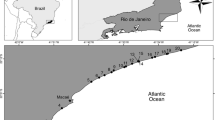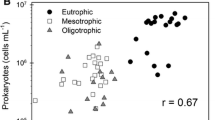Abstract
Heterotrophic bacterial and viral concentrations (range, 0.7 × 104 to 206.2 × 104 ml−1 and 0.05 × 106 to 128.9 × 106 ml−1, respectively) were determined in several Arctic freshwater environments, including lakes and glacial ecosystems (78.55°N, 11.56°E). Our bacteria and virus results mirrored trends seen in temperate lakes, with an average virus-to-bacteria ratio (VBR) of 13 (range, 7.3–25.2) and viral concentrations and DOC positively correlated with bacterial concentrations (R = 0.964, P < 0.01 and R = 0.813, P < 0.05, respectively). Lysogenic bacteria, determined by induction with Mitomycin C, were not detected in any of the investigated Arctic freshwater environments. Nutrient-addition experiments at in situ and at elevated temperatures were performed to elucidate the factors which influenced the bacterial growth and the virus–bacteria interactions in Arctic freshwaters. Our results suggest that multiple limiting factors interacted and constrained bacterial growth. Bacterial concentrations and doubling times increased at elevated temperatures and appeared to be co-stimulated by phosphorus and carbon. However, viral concentrations showed a lack of response to nutrient addition thus indicating an uncoupling between bacteria and viruses in the experiment.




Similar content being viewed by others
References
Anesio AM, Hollas C, Granéli W, Laybourn-Parry J (2004) Influence of humic substances on bacterial and viral dynamics in freshwaters Appl Environ Microbiol 70:4848–4854
Bell RT (1993) Estimating production of heterotrophic bacterioplankton via the incorporation of tritiated thymidine. In: Kemp BF, Sherr EB, Cole JJ (eds) Handbook of methods in aquatic microbial ecology. CRC , Boca Raton, pp 495–503
Bratbak G, Dundas I (1984) Bacterial dry matter content and biomass estimations. Appl Environ Microbiol 48:755–757
Carlsson P, Caron DA (2001) Seasonal variation of phosphorus limitation of bacterial growth in a small lake. Limnol Oceanogr 46:108–120
Cochran PK, Kellogg CA, Paul JH(1998) Prophage induction of indigenous marine lysogenic bacteria by environmental pollutants. Mar Ecol Progr Ser 164:125–133
del Giorgio P, Bird DF, Prairie YT, Planas D (1996) Flow cytometric determination of bacterial abundance in lake plankton with green nucleic acid stain SYTO-13. Limnol Oceanogr 41:783–789
Ellis-Evans JC, Galchenko V, Laybourn-Parry J, Mylnikov AP, Petz W (2001) Environmental characteristic and microbial plankton activity of freshwater environments at Kongsfjorden, Spitsbergen (Svalbard). Arch Hydrobiol 152:609–632
Elser JJ, Stabler LB, Hasset RP (1995) Nutrient limitation of bacterial growth and rates of bacterivory in lakes and oceans: a comparative study. Aquat Microb Ecol 9:105–110
Farjalla VF, Esteves FA, Bozelli RL, Roland F (2002) Nutrient limitation of bacterial production in clear water Amazonian ecosystems. Hydrobiol 489:197–205
Granéli W, Bertilsson S, Philibert A (2004a) Phosphorus limitation of bacterial growth in high Arctic lakes and ponds. Aquat Sci 66:430–439
Granéli W, Carlsson P, Bertilsson S (2004b) Bacterial abundance, production and organic carbon limitation in the Southern Ocean (39–62°S, 4–14°E) during the austral summer 1997/1998. Deep-Sea Res II 51:2569–2582
Guillard RRL (1973) Division rates. In: Stein JR (ed) Handbook of phycological methods, culture methods and growth measurements, Cambridge Univ Press, Cambridge, pp 289–312
Hofer JS, Sommaruga R (2001) Seasonal dynamics of viruses in an alpine lake: importance of filamentous forms. Aquat Microb Ecol 26:1–11
Jespersen AM, Christoffersen K (1987) Measurements of chlorophyll a from phytoplankton using ethanol as extraction solvent. Arch Hydrobiol 109:445–454
Jiang SC, Paul JH (1996) Occurrence of lysogenic bacteria in marine microbial communities as determined by prophage induction Mar Ecol Progr Ser 142:27–38
Kepner RL, Wharton RA, Suttle CA (1998) Viruses in Antarctic lakes. Limnol Oceanogr 43:1754–1761
Kirchman D (2001) Measuring bacterial biomass production and growth rates from leucine incorporation in natural aquatic environments. In: Paul JH (ed) Marine microbiology—methods in microbiology. Academic, London, pp. 225–237
Kirchman DL, Rich JH (1997) Regulation of bacterial growth rates by dissolved organic carbon and temperature in the equatorial Pacific Ocean. Microb Ecol 33:11–20
Laybourn-Parry J (1997) The microbial loop in Antarctic lakes. In: Howard-Williams C, Lyons W, Hawes I (eds) Ecosystem processes in Antarctic ice-free landscapes, AA Balkema, Rotterdam, pp 231–240
Laybourn-Parry J, Hofer JS, Sommaruga R (2001) Viruses in the plankton of freshwater and saline Antarctic lakes. Freshwater Biol 46:1279–1287
Laybourn-Parry J, Henshaw T, Jones DJ, Quayle W (2004) Bacterioplankton production in freshwater Antarctic lakes. Freshwater Biol 49:735–744
Laybourn-Parry J, Marshall WA, Madan NJ (2006) Viral dynamics and patterns of lysogeny in saline Antarctic lakes. Polar Biol 30:351–358
Lisle JT, Priscu JC (2004) The occurrence of lysogenic bacteria and microbial aggregates in the lakes of the McMurdo Dry valleys, Antarctica. Microb Ecol 47:427–439
Lenski RE (1988) Dynamics of interactions between bacteria and virulent bacteriophage. Adv Microb Ecol 10:1–44
Madan NJ, Marshall WA, Laybourn-Parry J (2005) Virus and microbial loop dynamics over and annual cycle in three contrasting Antarctic lakes. Freshwater Biol 50:1291–1300
Miller RV (2001) Environmental bacteriophage-host interactions: factors contribution to natural transduction. Antonie Van Leeuwenhoek Int J Gen Mol Microbiol 79:14–147
Moebus K (1996) Marine bacteriophage reproduction under nutrient-limited growth of host bacteria. I. Investigations with six phage-host systems Mar Ecol Progr Ser 144:1–12
Nedwell DB (1999) Effect of low temperature on microbial growth: lowered affinity for substrates limits growth at low temperature. FEMS Microbiol Ecol 30:101–111
Noble RT, Fuhrman JA (1998) Use of SYBR Green I for rapid epifluorescence counts of marine viruses and bacteria. Aquat Microb Ecol 14:113–118
Panzenböck M, Möbes-Hansen B, Albert R, Herndl GJ (2000) Dynamics of phyto- and bacterioplankton in a high Arctic lake on Franz Joseph Land archipelago. Aquat Microb Ecol 21:265–273
Paul JH, Jiang SC (2001) Lysogeny and transduction. In: Paul JH (ed) Marine microbiology—methods in microbiology, Academic , London, pp 105–125
Pomeroy LR, Wiebe WJ (2001) Temperature and substrates as interactive limiting factors for marine heterotrophic bacteria. Aquat Microb Ecol 23:187–204
Reay DS, Nedwell DB, Priddle J, Ellis-Evans JC (1999) Temperature dependence of inorganic nitrogen uptake: reduced affinity for nitrate at suboptimal temperatures in both algae and bacteria. Appl Environ Microbiol 65:2577–2584
Shiah F, Ducklow HW (1994) Temperature regulation of heterotrophic bacterioplankton abundance, production and scpecific growth rate in Chesapeake Bay. Limnol Oceanogr 39:1243–1258
Säwström C, Mumford P, Marshall WA, Hodson A, Laybourn-Parry J (2002) The microbial communities and primary productivity of cryoconite holes in and Arctic glacier (Svalbard 79°N). Polar Biol 25:591–596
Säwström C, Anesio AM, Granéli W, Laybourn-Parry J (2007) Seasonal viral loop dynamics in two large ultra-oligotrophic Antarctic freshwater lakes. Microb Ecol 53:1–11
Tapper MA, Hicks RE (1998) Temperate viruses and lysogeny in Lake Superior bacterioplankton. Limnol Oceanogr 43:95–103
Thingstad TF (2000) Elements of theory for the mechanisms controlling abundance, diversity, and biogeochemical role of lytic bacterial viruses in aquatic systems. Limnol Oceanogr 45:1320–1328
Weinbauer MG (2004) Ecology of prokaryotic viruses. FEMS Microbiol Rev 28:127–181
Weinbauer MG, Suttle C (1996) Potential significance of lysogeny to bacteriophage production and bacterial mortality in coastal water of the Gulf of Mexico. Appl Environ Microbiol 62:4374–4380
Wharton RA, McKay CP, Simmons GM, Parker BC (1985) Cryoconite holes on glaciers. Bioscience 35:499–503
White PA, Kalff J, Rasmussen JB, Gasol JM (1991) The effect of temperature and algal biomass on bacterial production and specific growth rate in freshwater and marine habitats. Microb Ecol 21:99–118
Wiebe WJ, Sheldon WM, Pomeroy LR (1992) Bacterial growth in the cold: Evidence for and enhanced substrate requirement. Appl Environ Microbiol 58:359–364
Wilhelm SW, Suttle CA (1999) Viruses and nutrient cycles in the sea. Biosci 49:781–788
Wilson WH, Mann NH (1997) Lysogenic and lytic viral production in marine microbial communities. Aquat Microb Ecol 13:95–100
Wommack KE, RR Colwell (2000) Virioplankton: viruses in aquatic ecosystems. Microbiol. Mol Biol Rev 64:69–114
Yager PL, Deming JW (1999) Pelagic microbial activity in an arctic polynya: testing for temperature and substrate interactions using a kinetic approach. Limnol Oceanogr 44:1882–1893
Yager PL, Connelly TL, Mortazavi B, Wommack KE, Bano N, Bauer JE, Opsahl S, Hollibaugh JT (2001) Dynamic bacterial and viral response to an algal bloom at subzero temperatures. Limnol Oceanogr 46:790–801
Acknowledgments
This work was funded by VR the Swedish Reasearch Council held by W Granéli and the Nuffield Foundation held by A Anesio. We are indebted to Nick Cox the Station Manager of the NERC Arctic Station for assistance with fieldwork. Thanks are due to three anonymous reviewers for valuable comments on an earlier draft of the manuscript.
Author information
Authors and Affiliations
Corresponding author
Rights and permissions
About this article
Cite this article
Säwström, C., Laybourn-Parry, J., Granéli, W. et al. Heterotrophic bacterial and viral dynamics in Arctic freshwaters: results from a field study and nutrient-temperature manipulation experiments. Polar Biol 30, 1407–1415 (2007). https://doi.org/10.1007/s00300-007-0301-3
Received:
Revised:
Accepted:
Published:
Issue Date:
DOI: https://doi.org/10.1007/s00300-007-0301-3




